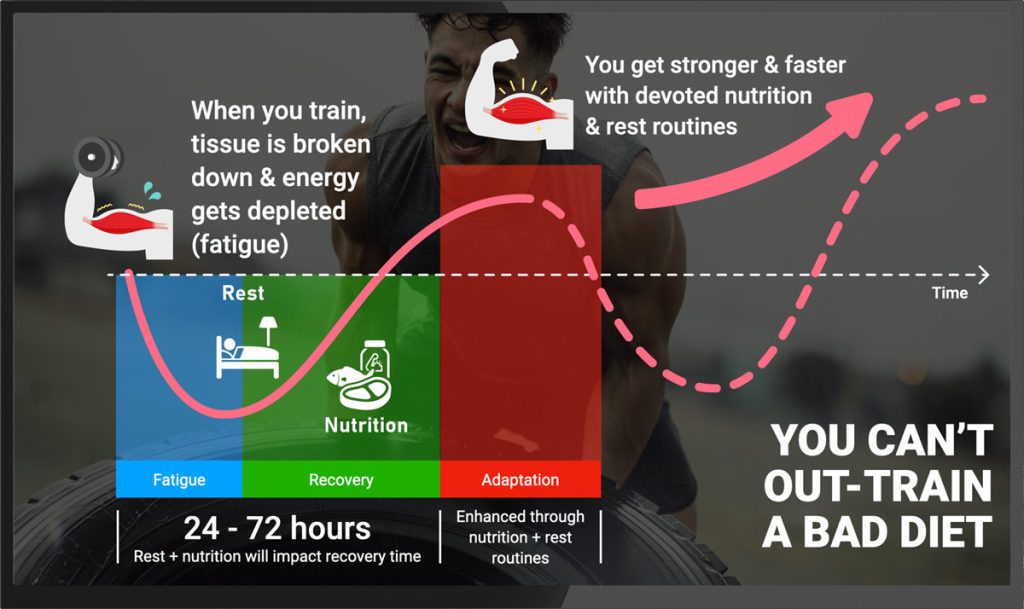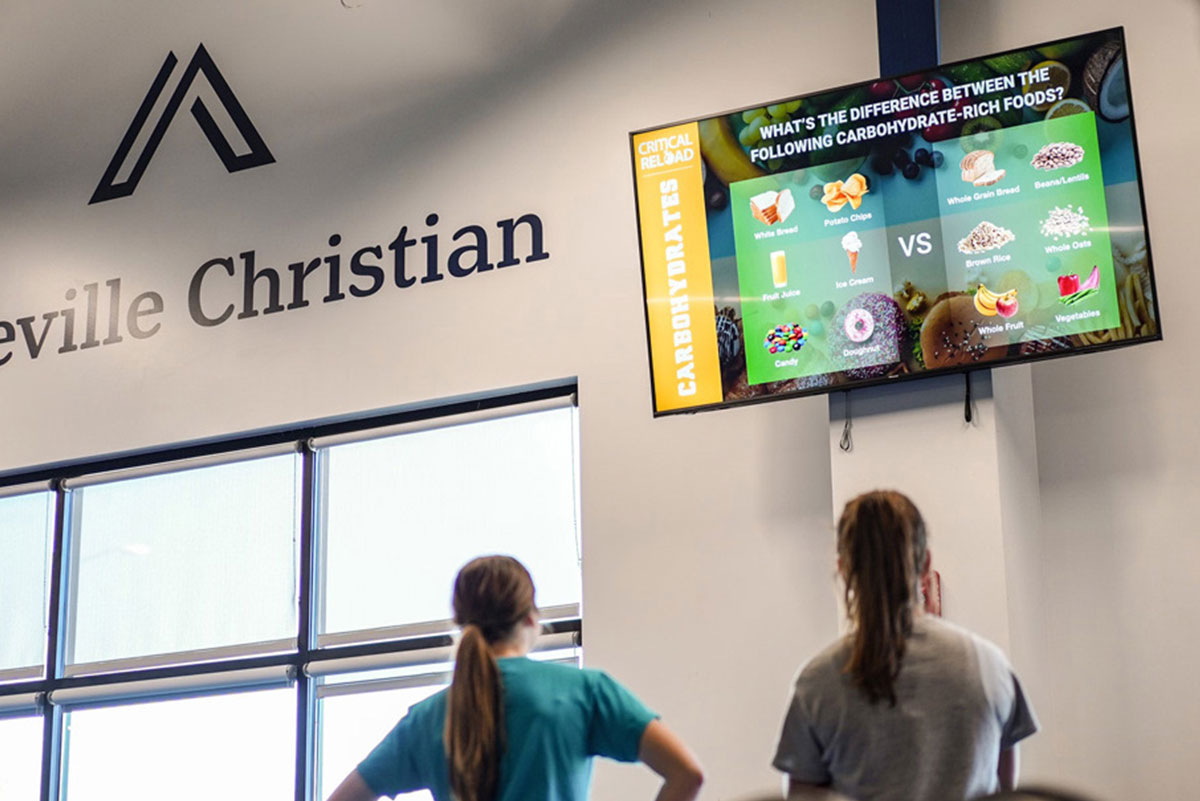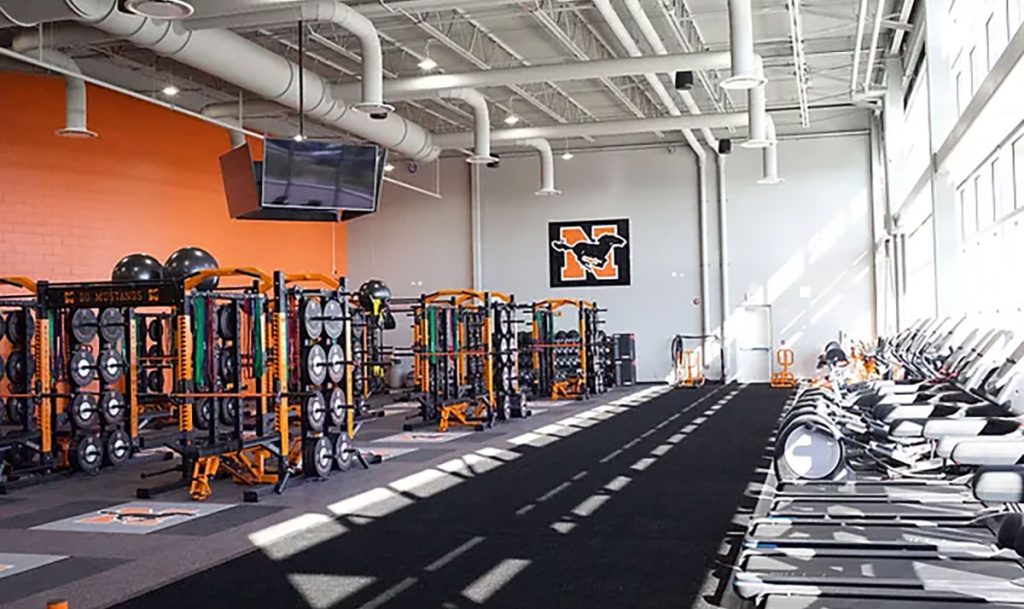Description
Benefits & Features
DAILY TALKING POINTS
Coaches’ daily talking points for athletes’ training session kickoff
SAVE TIME
Deliver nutrition information without thinking about it
CONVENIENCE
Use your TV to present streamed nutrition information immediately
RELIABLE CONTENT
Streams gathered nutritional facts based on the latest research
EFFORTLESS LEARNING
Athletes acquire nutritional wisdom in a brief summarized format
Fuel Performance in Bite-Sized Streams
Maximize athlete health and performance with weekly Critical Reload Streams.

Quick Streams & Talking Points
Discover the transformative power of Critical Reload Stream, where nutrition education comes alive in convenient and engaging 6-10 minute streams paired with daily Talking Points to kick-off each training session.
Imagine the impact of delivering valuable nutrition insights multiple times per week, perfectly complementing athletes’ training routines.
Each week, as athletes dedicate themselves to training 3 times a week, for 30 to 60 minutes per session, they’ll have the opportunity to reinforce their nutrition education through repeated exposure to the streamed content and daily Talking Points.
With consistent engagement, athletes will develop a deep understanding of vital nutrition concepts and gain practical knowledge that they can apply to optimize their performance.
The ‘micro-dosed’ nature of our streams ensures that athletes can easily absorb and retain the information without adding excessive time demands to their already busy training schedules.
This regular exposure to nutrition education will help build a solid foundation of knowledge and empower athletes to make informed choices that enhance their performance and overall well-being.
Experience the highest level of nutrition education with Critical Reload Stream, where you can access sourced content delivered by the nation’s top board-certified specialists in sports dietetics, registered dietitians, certified strength and conditioning specialists, and nationally recognized educators.
With Critical Reload Stream, you can trust that you receive the most up-to-date and credible nutrition education from industry-leading professionals.

HOW TO START AND DELIVER STREAM
Step 1: Choose Your TV
Begin your TV upgrade or first-time purchase journey here. Explore budget-friendly 50″ TVs at a leading discount retail giant for under $200 on average.
Step 2: Mount & Display
For first-time buyers, select a mounting location in a common area where athletes gather before starting. Opt for a wall mount or mobile cart for flexibility.
Step 3: Stream Anywhere
Access Critical Reload Stream on any device — mobile, tablet, or laptop — and stream via Airplay or Google Cast.
Step 4: Deliver Talking Points
Kickstart workouts with Stream’s Daily Talking Points to captivate athletes’ attention on TV broadcasts, ideal for nutrition education during active rest during workouts.
Stream’s Daily Talking Points
Daily Talking Points don’t require a coach to consider what to summarize or talk about with athletes. It does the work for them and allows coaches to deliver their nutrition message consistently daily and in a matter of seconds.
Ready-Made Content
Eliminates the need for coaches to plan daily nutrition discussions.
Consistent Delivery
Ensures a steady flow of nutrition education with minimal effort.
Time-
Efficient
Enables quick dissemination of information, saving valuable time.
Engaging Broadcasts
Captures athletes’ attention through TV broadcasts during workouts.
Education During Rest
Utilizes active rest periods for productive nutrition learning.
Streamlined Messaging
Provides a structured approach to daily nutrition messaging.
Interactive Learning
Encourages athlete engagement with dynamic, visual content.
Seamless Integration
Easily incorporated into existing workout routines without disruption.
Stream Broadcast Example & Talking Points
Dive into a featured Critical Reload Stream broadcast and adjacent Talking Points for a focused insight on how Stream provides a structured approach to daily nutrition messaging
The Critical Role of Recovery in Sports Nutrition: This week, we’re emphasizing the crucial aspect of recovery in sports nutrition. Recovery isn’t just about resting your body; it’s about actively fueling and refueling your muscles and systems to adapt and strengthen for future challenges. Understanding the role of nutrition in recovery will help us enhance performance, reduce injury risks, and ensure you’re ready for the next training session
Post-Workout Nutrition for Optimal Recovery: Effective recovery nutrition involves a combination of carbohydrates, proteins, fluids, and electrolytes to replenish fuel stores, support tissue repair, and rehydrate. Today, we’ll explore the components of an ideal post-workout meal and how it can speed up recovery, improve performance, and reduce the chance of injury.
The Timing and Composition of Recovery Meals: The timing of your post-workout nutrition is key to maximizing recovery. Consuming the right balance of carbohydrates and protein within 30 minutes after intense exercise can significantly enhance recovery outcomes. We’ll discuss the importance of macronutrient ratios and timing to facilitate muscle protein synthesis and replenish glycogen stores effectively.
Hydration as a Pillar of Recovery:
Rehydration is an essential part of the recovery process, especially after intense or prolonged exercise. Today, we’ll cover effective strategies for rehydrating, including the role of sodium and other electrolytes in fluid absorption, and how to assess and replace fluid losses accurately to ensure you’re adequately hydrated for your next workout.
Implementing a Recovery Nutrition Plan: To conclude our focus on recovery, we’ll discuss practical ways to implement a recovery nutrition plan, including meal planning strategies and setting reminders for post-workout nutrition. Effective recovery goes beyond the training session, encompassing strategic nutrition and hydration practices that support your body’s adaptation and prepare it for future performance demands.
The Critical Reload Nutrition Calculator
Your Personalized Nutrition Architect, providing accessible, personalized, and comprehensive nutrition education and support
Discover the power of the Calculator in this video series
How To Set Up Your Profile
Calorie Burn: Part 1
Calorie Burn: Part 2
Hydration & Performance
Meal Planning
Nutrient Ratios
5-Day Sample Menu
Submitting Your Results
Accessibility through QR Codes
By allowing athletes to scan a QR code to access the CR Calculator, you’re leveraging modern technology to simplify the process of obtaining personalized nutritional advice. This method ensures that the tool is easily accessible to anyone with a smartphone, increasing its reach and utility.
Charging a modest fee of $1.99 for each submission to receive nutritional calculations and a meal plan is a cost-effective way for athletes to access customized nutrition advice. This pricing strategy makes it an attractive option for students or athletes who are looking for a budget-friendly solution to optimize their nutrition.
By enabling users to enter their own information, the Nutrition Calculator can provide highly personalized nutrition calculations and meal plans. This tailored approach ensures that each athlete receives recommendations that are specifically aligned with their individual health goals, activity levels, and dietary preferences.
Offering the Nutrition Calculator as part of the Stream encourages ongoing engagement with the tool, allowing students to adjust their nutrition plans as their needs, goals, or circumstances change. It promotes a continuous learning process and helps students adapt their nutrition strategies to support their evolving athletic and academic endeavors.
Making the Nutrition Calculator available ties into a broader educational context, where nutrition can be integrated into health, physical education, or sports training curriculums. This approach not only supports the physical well-being of students but also educates them on the importance of nutrition in achieving peak performance and maintaining overall health.
What customers say about Stream
Elevating Athletic Performance
Our athletes have greatly benefited from Critical Reload Stream. We now have dedicated lessons every Friday, enhancing our nutrition discussions significantly. This platform provides us with valuable talking points that elevate our conversations about fueling for performance.

Corey Roy
Director of Athletic Performance
Ozark High School (MO)
Engages and Empowers Athletes
I’ve seen the impact of Critical Reload Stream on our athletes. The information is presented in a simple and digestible format. Our students appreciate that it’s not a pile of reading material. It’s accessible, engaging, and makes a real difference in their nutrition education journey.

John Estok
Head Strength & Conditioning Coach
William Penn Charter School (PA)
Nutrition Education on a Budget
At Piedmont University, we understand the budget constraints of an NCAA Division-III institution. That’s why partnering with Critical Reload Stream is a game-changer for us! It offers our athletes top-tier nutrition knowledge within our means.

John Delf-Montgomery
Head Strength and Conditioning Coordinator
Piedmont University
Transforms Training Sessions
I’m Incorporating Critical Reload Stream’s educational content into my sessions. This shift not only elevates the physical training but also transforms the space into a dual-purpose classroom where I can embody the role of coach and educator, empowering my students with strength and nutrition knowledge.

Ryan Johnson
Head Strength & Conditioning Coach
Wayzata High School (MI)
Genuine Conversations
I’ve had more genuine nutrition conversations in the last 10 days than I’ve had in the last 2 years with Critical Reload Stream.

Nick Ficker
Head Strength & Conditioning Coach
Asheville Christian School (NC)
Surprising Impact
I started Critical Reload Stream in the school cafeteria while the students ate breakfast, but I expected resistance from the kids who wanted popular streaming services. Surprisingly, their initial disappointment quickly turned into active engagement, as they began attempting to answer questions and interact with each other over the content. I couldn’t believe it!

Nolan Vandenberg
Head Strength & Conditioning Coach
Boone Central HS (NE)
Stream In Various Settings
Discover the versatility of Critical Reload Stream as it seamlessly fits into multiple settings, enabling students and athletes to access nutrition education wherever they are.
Playing Critical Reload Stream in the weight room allows athletes to learn about nutrition’s role in strength training and muscle recovery.
Athletes can access workout-specific nutrition guidance, meal planning ideas, and expert tips to optimize their nutrition around weightlifting sessions.
Having Critical Reload Stream playing in the weight room exposes athletes to evidence-based nutrition education while focusing on building strength and achieving their fitness goals.
Critical Reload Stream can be played in the locker room, providing an engaging and educational resource for athletes during pre- and post-workout routines.
Athletes can access valuable nutrition tips, hydration strategies, and performance-enhancing insights right in the locker room, helping them make informed choices about their nutrition and well-being.
Incorporating Critical Reload Stream in the locker room creates a culture of nutrition awareness and supports athletes in their overall performance and recovery goals.
Displaying Critical Reload Stream in the cafeteria can provide a valuable resource for students to learn about healthy eating choices and make informed decisions about their meals.
Athletes can access meal planning ideas, nutrition facts, and practical tips for balancing their food choices to support their performance goals.
By featuring Critical Reload Stream in the cafeteria, you create a nutrition-focused environment that encourages students to develop lifelong healthy eating habits.
Critical Reload Stream can be played in multi-purpose areas such as common rooms or gathering spaces, allowing athletes and students to access nutrition education content conveniently.
Incorporating Critical Reload TV Stream in these areas ensures that nutrition education is accessible to a broader audience, fostering a culture of wellness throughout the school community.
Athletes and students can gather, engage, and learn together, discussing nutrition topics and exchanging ideas for optimal performance and well-being.
Ready To Start StreamING?
Schedule a Meeting Directly with Our Team of Sports Nutrition Experts to discuss how Critical Reload can transform your school’s health and performance

Critical Reload Stream FAQ
Frequently asked questions about Critical Reload Stream
Critical Reload Stream Costs $300 annually. The cost does NOT vary based on the school size or number of students.
How is the program implemented within a school setting? What resources or equipment are needed?
Critical Reload Stream integrates into school settings through dynamic TV broadcasts featuring nutrition experts. Designed for athletes, it fits seamlessly into their training and academic schedules. The program offers 6-10 minute engaging streams, with daily Talking Points for quick, effective nutrition education. It’s broadcasted in environments like the weight room, enhancing learning without disrupting routines. This approach ensures athletes receive consistent, valuable nutrition insights, aiding performance and well-being. Exploring the full program offerings is recommended for detailed insights and implementation strategies.
To implement Critical Reload Stream, begin with selecting a suitable TV or utilize a SMART Board. Ensure the chosen display is mounted in a common area accessible to athletes. The program is adaptable, allowing streaming on various devices, including mobiles, tablets, or laptops, through Airplay or Google Cast. Kickstart sessions with the program’s Daily Talking Points to engage athletes during workouts, making it an ideal tool for integrating nutrition education seamlessly into their routine.
Can the content be customized to fit our students’ and athletes’ needs or interests?
Critical Reload offers comprehensive support and training to ensure educators and coaches can effectively implement the program. This includes an initial Zoom meeting to discuss broadcasting methods, access to a private group for community learning and support, and a SMART Goals framework for integrating the program with measurable outcomes and structured rollout plans. These resources aim to facilitate seamless integration and maximize the program’s impact on student and athlete nutrition education.
Critical Reload offers a multifaceted support and training system for educators and coaches, including an initial setup Zoom meeting, access to a private group for community support, and a SMART Goals framework. This framework ensures strategic integration, measures outcomes, provides phased rollout plans, and demonstrates the program’s value, facilitating its effective implementation in physical health education and athletic training curriculums.
Are there other studies or examples of the program’s success in different schools or settings
Yes, Wayzata (MN) High School students who participated in the Critical Reload nutrition program over an 18-week semester reveals significant positive impacts. Students reported improved knowledge and awareness of nutrition, healthier eating habits, enhanced athletic performance, and a general appreciation for the program. Themes from their responses include understanding the importance of specific nutrients, making healthier food choices, recognizing the role of nutrition in recovery, and experiencing lifting gains and improved energy levels. The data suggests that integrating the Critical Reload Stream into their curriculum effectively enhanced students’ nutritional knowledge and positively influenced their behaviors and performance in sports.
We’d love to share the actual case study results and student feedback. Use our Calendar App to find a convenient time to connect so we can share Critical Reload Stream’s positive impact.
Critical Reload Stream is versatile, fitting both short-term and semester-long courses with its extensive content of over 33 chapters in 11 units. Tailored to meet diverse educational timelines, our program has been successfully integrated into various school curriculums, demonstrating its effectiveness in enhancing nutrition education and application. We’d love to support your unique needs. Let’s discuss how Critical Reload Stream can best complement your educational goals. We invite you to schedule a call to explore how it can best serve your school and discuss a tailored implementation strategy. Please use our Calendar App to find a convenient time. Let’s make nutrition education impactful together.
The Critical Reload Stream engages students with varied interests in nutrition through accessible tools like a Nutrition Calculator, which offers personalized advice and meal plans. This, combined with SMART Goals—specific, measurable, achievable, relevant, and time-bound objectives—ensures tailored, expert-led nutrition education. The program’s implementation across diverse settings and integration into curricula promote continuous engagement. Addressing different dietary needs and including feedback mechanisms fosters an inclusive, educational environment that resonates with all students, enhancing their understanding and application of nutrition in their athletic and academic lives.
Yes. You are allowed to deliver nutritional information without being a licensed dietician so long as the information provided is sourced as such. Critical Reload Stream and all its nutritional information are sourced and reviewed by registered dietitians and board-certified sports dietetics specialists prior to publishing.
What size TV screen do I need?
Choosing the right TV size for your room depends on two critical factors: your budget and the size of the space.
While your budget may play a role, the size of your television should be determined by how crowded your weight room is on average. The smallest we suggest you go with is a 40-inch screen. If your budget allows, an ideal screen size is between 55 to 60-inch.
Do I need a Wifi connection to stream Critical Reload Stream?
Yes, we use your school’s network to stream Critical Reload Stream.
Is Critical Reload Stream secure on my school or company network?
Yes, Critical Reload Stream is secure on both school and company networks. The platform is designed to be accessed safely through a mobile device, school-issued tablet, or any laptop/desktop, ensuring compatibility and security across various network settings. Our system employs robust security measures to protect your data and streaming experience, allowing you to focus on enhancing nutrition education without compromising network safety.
Wherever you decide to put the TV in your weight room, you’ll almost always want to mount it to the wall instead of using a TV stand. If the gym will serve multiple people, average their heights and subtract 5 inches to ascertain average eye level. Place the middle of the TV slightly above this point to best accommodate the majority.
A single TV will work great utilizing Critical Reload Stream in your weight room.
As you program evolves, purchasing multiple smaller TVs is a great way to get the optimal viewing experience at various locations in your weight room without having to compromise.
A TV with screen technology with excellent viewing angles is OLEDs, followed by QLED, and LED-LCD TVs.

